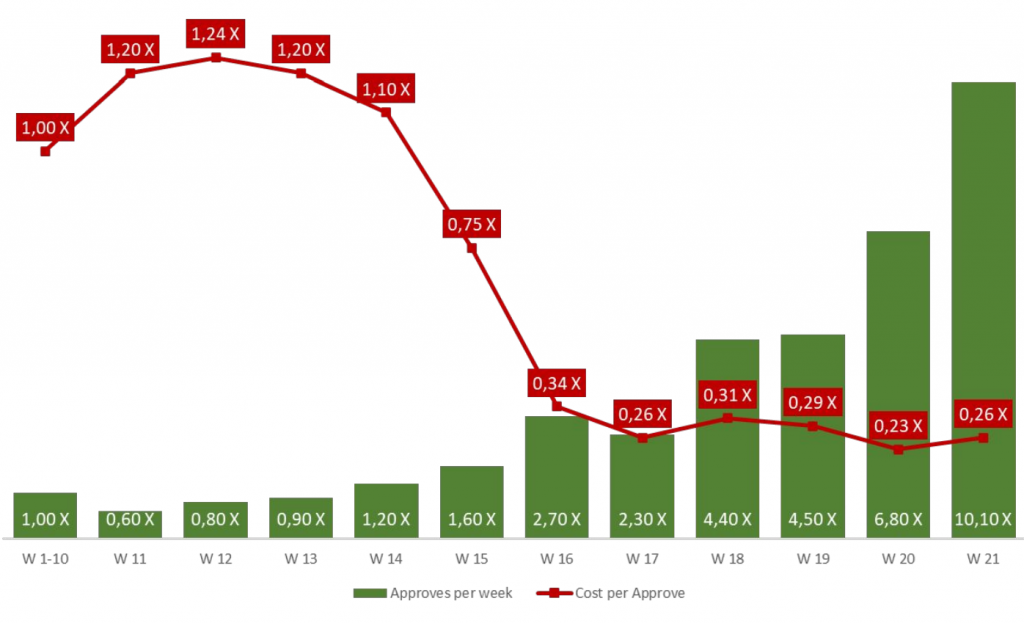Business Loan 2024: Case study & Meta Ads Guide

Introduction
There are several reasons to think about the approach to promote in Meta for business products.
The stated demand in search channels is limited and competition for the target customer turns into a price war where the user always opens several tabs. This does not mean that you need to give up on improvements in the product and user experience. But sometimes it’s more effective to expand media mix than to work with a channel where you are always close to the saturation threshold.
At the same time, targeted advertising technologies have long been non limited to finding an audience
according to interests or "likes". The Meta advertising product has long been 03 based on a strong optimization model that searches for customers "like yours" in real time.
However, this does not mean that you can just launch an ad campaign and it starts bringing leads. It is namely because of the complexity of work with the “smart” and efficient “black box” inside Meta that it is important to have your own approach.
In this edition, we’ll try to highlight the 4 key components of our approach that will help us understand the Meta impact and extract the result from the potential.
-
Defining the most important goal for the business. It is important to define the boundaries where media tasks end and business goals begin. How big is the gap between them?
-
It is necessary to decompose business goals into digital events on the website or your CRM. It is also important to understand what data on users and their actions you are willing to share with Meta
-
You need to understand how your message correlates with the expectations, real needs and capabilities of the client and how certain messages help Meta or, on the contrary, confuse it.
-
Analytics should become your interface for communicating with the Meta’s “black box” - the complicated algorithms inside Meta. You need to share the client’s movements along the whole sales funnel
It's becoming even more important if you are operating in the B2B sector
When you do lead generation for a business, providing loans for small and medium businesses, the lead processing chain is lengthy, and media requirements are higher than in retail or B2C services.
Companies or entrepreneurs do lots of researching before making a decision on where to loan money, so your offer has to be very attractive to them.
At the same time, you can’t trust everyone on social media and provide them a loan. It is critically important to combine your scoring model and the Meta conversion optimization model when placing ads.
All components of your approach should be focused on transparency in planning and buying of ads:
-
What is the reaction to the display of an advertising message?
-
What is the landing page conversion rate?
-
How many people are lost before the Risk analysis stage?
-
Why don't certain people get approved? Can the media campaign help the sales department after the approval?
There are many more lead stages and most of them are not online. And at each stage you have the opportunity to lose or gain an advantage.

01 BRIEFING #1. Let's define the business, marketing and media goals
Let's define the business goals
We see the goal setting as a crucial step, where it is not enough just to choose a lead price and start investing in advertising.
Where are you now? Start by diagnosing the current position.
Is your campaign already running or are you launching it for the first time? Decide what is more important at the moment - cost optimization or volume scaling.
What does your funnel look like? Which conversion steps inside the funnel cause large losses and which work at maximum efficiency? Determine which of the tools affect each stage and what potential they have
What are the key scoring parameters? What kind of company can have an approved loan? What parameters of revenue, balance sheet and credit score should it have?
Does Meta receive the necessary signals about the quality of the leads it’s delivering?
1.1 Before we start: What is our audience?
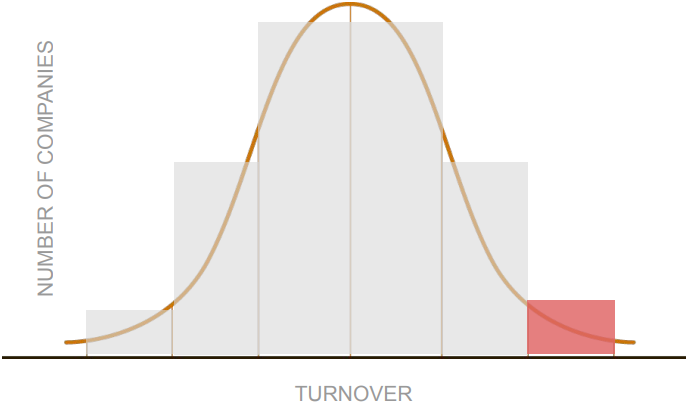
Optimal Planning & Buying Strategy - account based marketing or reach-based strategy.
Meta will have troubles finding this narrow audience. The result will not be sustainable, and the quality of leads will be low.

A wide audience of entrepreneurs - small and medium-sized companies
Optimal Planning & Buying Strategy - Lead Generation.
With a massive target audience, Meta will quickly find a set of users who meet the requirements. Due to the large capacity, a high level of result stability can be expected.
1.2 Before we start: Diagnostics of the current situation
Assess the current situation. If you are connecting the channel for the first time, then the “Lead” goal is most likely suitable for you. This will mean working with attracting leads without significant coverage, but with an acceptable lead cost. In this strategy, you will also be able to see direct return of investment in advertising by directly attributing clicks and requests.All other strategies also solve sales problems. But their use is more reasonable if you have already exhausted the potential at the lower stage of the funnel and you need to work with brand building to expand it.
There is no place for direct attribution here. You need to be prepared for marketing mix modeling to assess the indirect impact of brand investments on sales.
Next, we will analyze in detail the use of the “Lead” strategy to promote business loans products.
But let's look at what your steps might look like in general:
Strategy options in different basic positions

1.3 Before we start: What does your funnel look like?
Of course, your ultimate business goal is to issue loans with a satisfactory level of risk. But the first thing to do is to analyze all the indicators of the funnel.What happens if you increase the conversion rate at different stages of your funnel? Is it possible? And what tools can be used to achieve this?
Clicks on your web-site
The difference over 50% between your average CTR numbers and an average maximum indicates a high potential. It is advisable to start by auditing your creative materials.
Filling out the questionnaire
A low discrepancy between the average and maximum conversion values can indicate both the high quality of the page and the lack of diversity in communication.
Providing access to the account
Risk analytics
Usually, traffic does not show different results at this stage. Conversion depends on the quality of user experience and not on the quality of traffic.
Approval
If you have low results in conversion to qualified leads, it is important to understand what the problem is. Just the "approved" signal is not enough. It is important to figure out which scoring parameters the companies do not match. This may be the volume and stability of revenue, balance, creditworthiness, category, or anything else. It is important to understand exactly what is wrong.
Loan issuance
The sales department is responsible for the sale of an already approved loan, but it is important to make sure that “approved” is a fully qualified lead.
1.4 Before we start: What are your key scoring parameters?
What does the “target” company, to which you are ready to provide a loan, look like? And what do those who come now look like?We analyzed the companies that gave access to their account analytics. In our case, we saw that Meta was bringing us companies of different sizes and with different checks frequency.
The distribution of companies by revenue and the frequency of receipts is subject to Gauss's law (Chart 1).
More than 50% of all companies have revenue over $60 thousand per year and the frequency of receipts is over 10 checks per month.
But what is much more important is not the average values, but the fact that this distribution can be influenced by showing different messages or targeting different regions.
If your media buying team knows which companies you need, it will be able to influence the result.
In order for the problem of lead quality not to seem insoluble at this stage, have a look at Chart 2, showing how the cost of attracting companies of different sizes may look different for different communications.
But while we are at the briefing stage, let's agree that your media team needs information about the planned requirements for the target companies.
Approval
If you have low results in conversion to to qualified leads, it is important to understand what the problem is Just the "approved/not approved" signal is not enough. It is important to figure out which scoring parameters the attracted companies do not match. This may be the volume and stability of revenue, balance, creditworthiness, category, or anything else. It is important to understand exactly what is wrong.
The average amount of annual revenue and the average number of monthly receipts (Chart 1)
Annual turnover (log) - on the x-axis average monthly receipts (log) - on the y-axis
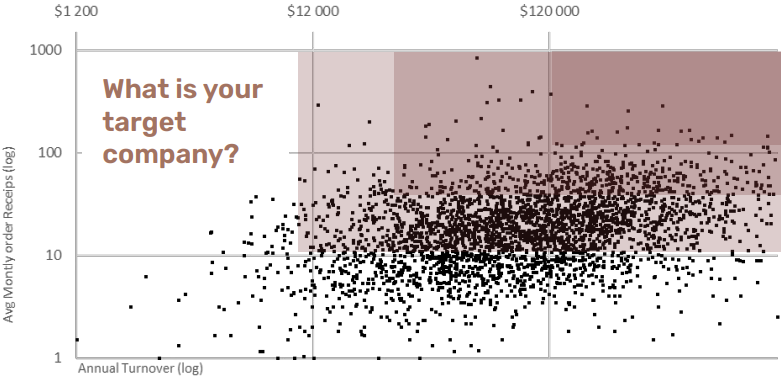
The average cost per lead for a company with the AVG daily balance (positive balance) and annual turnover (over $60k) by different creatives (Chart 2)
2.1 Cost per lead by creatives Only companies with AVG daily balance (positive balance)

2.1 Cost per lead by creatives Only companies with annual turnover over 60k USD

KEY TAKEAWAYS
- Make sure that Meta's performance marketing solutions are suitable for you. If you are targeting corporations, it may be better to look into Account based marketing;
- Determine the current positions and choose a strategy for working with the ads purchase;
- Define targets for a lead value, a qualified lead, and the final approval;
- Determine the scoring criteria and the portrait of the company by turnover, balance sheet and credit load

02 EVENT MANAGEMENT #2. Let's set up digital events
Let's set up digital events
After we’ve made sure that the channel is suitable for us and have decided which companies and at what price we need, we need to share our plan with Meta.How can we describe our key goal in a “macro conversion” format?
What is the main event that occurs when our goal is achieved? Maybe this event is completed by a user on the site, or maybe it is carried out by a manager in your CRM system?
Which events precede it and can be called a “micro conversion”?
These events will be higher up the funnel, they will be less valuable, but there will be significantly more of them.
What data will these events have?
How do we share the site information for attribution? How can we make sure Meta understands for sure which impression led to this or that micro- or macro conversion?
How do we ensure the existence of our attribution in the world without cookies?
Tracking user behavior in a browser is limited; much data is not available for pixel use. Does our workflow solve this problem?
2.1 Conversion campaign - How does it work?
What does the basic attribution process of performing an action and displaying an ad look like?What does the user do?
- The user sees the advertisement in the feed or elsewhere and goes to the website
- The user commits an action on the website and leaves
- Meta assigns a click identifier to the display of this ad even before the user has clicked on it
- When the user performs an action, Meta receives information about which impression and which user has led to the conversion
- Meta algorithm starts looking for similar users and similar ad impression conditions based on the conversion
The action can be performed outside the Meta contour. For example, after seeing the ad, the user goes to your website and leaves a request. It can also be your robot that changes the status of the application (which means that the goal has been achieved).
Regardless of where the action was performed, and how many hours after the impression, Meta will be able to find the impression that caused the conversion.
To get this working, the event to be sent must be accompanied by the user parameters:
- User IP
- User email
- User phone
- Click ID / User Agent
At the same time, you can have multiple events on the same website - for example, micro conversions or conversions related to another product.
Meta will not be able to understand what action the user has performed even if it finds this user in its system. In order for this to be clear, it is necessary to accompany the sending of the event not only with information about the user, but also with data about the event itself.
These will be the event parameters:
- Event Name
- Event ID
- Event Source
- Timestamp
2.2 Browser & Server side
Privacy standards and competition between ecosystems complicate your event management processesYou should start collecting events both by pixel and by using Conversion API to minimize data loss from Safari, Chrome, Firefox browsers.
You should also enable and configure the deduplication parameters so that Meta does not receive double false signals about the achievement of the goal.

2.3 Which events are available for tracking?
How to choose the optimal gap between business and media goals?As we approach the stage of issuing a loan, its value for business grows. But this does not mean that the value of information for Meta optimization increases proportionally.
By sending more valuable events to Meta, we can try to focus it on a more targeted audience. But if there are not enough events, or they arrive very late, they may become useless.
It is necessary to find a balance in which sufficiently valuable events are being sent to Meta in the amount of at least 50 per week.
You might need to run a test to determine the most effective event.
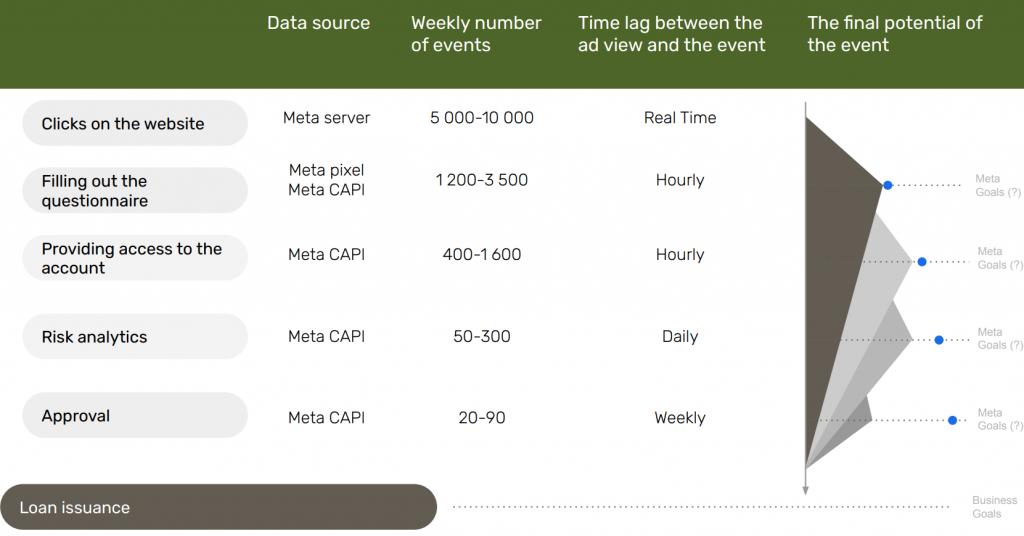
2.4 Which events are available for tracking?
Step 1: The user on the website proceeds to the registration of the applicationStep 2: The user fills out the application and submits the application
Step 3: In the CRM, a qualified lead is marked as a target (and goes to the appropriate stage)
KEY TAKEAWAYS
- Having determined what the business funnel looks like, it is important to digitize it. A digital event must correspond to each stage of the business.
- All events sent to the Meta server must contain information about the event and information about the user.
- It is important to choose the optimal event to optimize the conversion - on the one hand, so that it is of sufficient quality, on the other hand, so that it is sufficiently frequent

03 CREATIVES #3. It's time to get inspired!
3.1 Before we start: What are the specifics of your audience and product?
There are some restrictions for the promotion of credit products. For example, Meta prohibits advertising short-term and microloans.Think over the landing page and messages in such a way that you do not face restrictions when promoting your product.
Many standard targeting options will also be unavailable to you, such as income level or Look-a-like targeting.
Think about applying "message targeting" at the start of your campaign's training. What characteristics will be important in scoring? If the company profile is important to you, then the creative materials will have to highlight this segment of business that you need. If you have specific requirements for the size of the company, specify this in the message.
How will it work?
Your Approach
You are targeting a wide audience of entrepreneurs interested in loans.
You also show a clear limitation on the company's turnover on the creative materials.
User engagement
Users who don’t meet the requirement inevitably click less.
ctr among those who meet the requirements is starting to grow.
Campaign Training
Meta is starting to shift its focus towards the segment where it can result in more clicks with fewer impressions.
3.2 What does your Learning agenda consist of?
Look at your canvas as a designer. Remember that each element of this constructor can have an impact. Test as many variables as possible.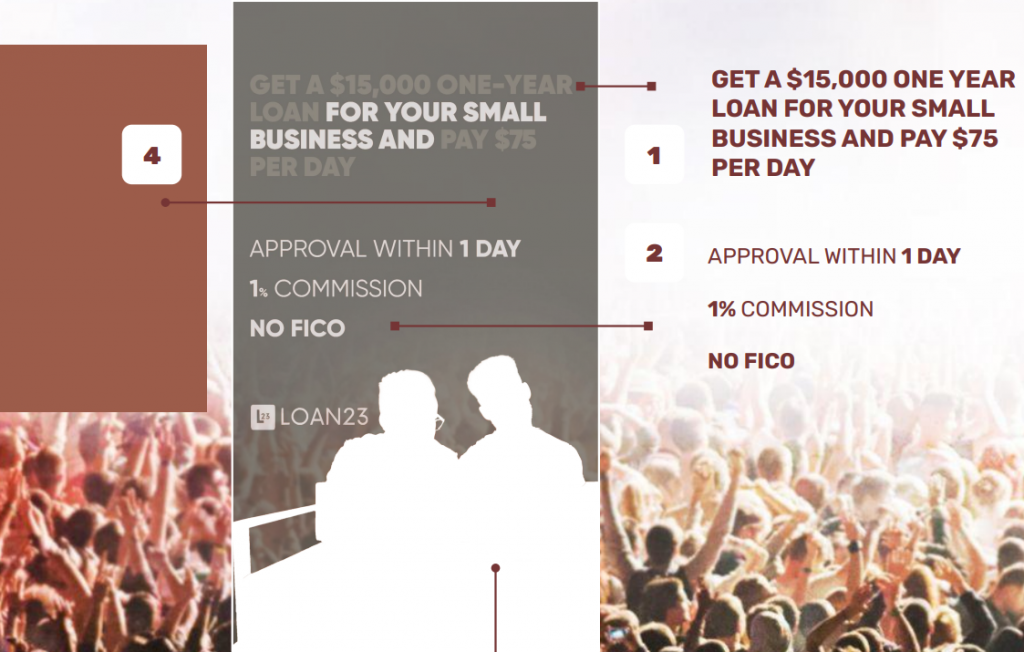
Your opportunities are diverse:
1.1 Product & offer:
- Loan amount;
- Loan term;
- Regular payment;
- The loan rate;
- Purpose of the loan;
- SMB loan;
- Business loan;
- Urgent;
- Quick loan;
- Turnover;
- Age of the company;
- Category;
- Quick approval;
- With no check;
- No FICO;
- The loan rate;
- Quick application;
- Diversity of people:
- people with smile;
- people w/o smile;
- people with laptop;
- people with reports;
- people at work;
- w/o people;
- Diversity of money images:
- money pack;
- w/o money;
- Diversity of business types:
- Baker,
- Salesman,
- Builder,
- Locksmith,
- Business consultant,
- Barber
- etc.
- Warm-color
- flat
- gradient
- Cold-color
- flat
- gradient
- Image-overlay
3.3 The quality depends on communication
Companies of different sizes will carry out various approaches to communication. Often, creativity in Meta will lead to way higher results than what campaigns in Google can achieveOn the graph: the proportion of companies by their size among those with different communication options. Only companies transferred to the risk analysis stage. CRE-1,2,3.. 8 - Different communications tests in Meta Google Ads - AVG Google search result

The same is true for the company's balance sheet. Meta is highly dependent on communication and shows better results vs Google
On the graph: the share of companies broken down by positive and negative balance for various communication options. Only companies that have been moved to the risk analysis stage. CRE-1,2,3.. 8 - Different communications tests in Meta Google Ads - AVG Google search result

3.3 Before we start: Don't waste money on the test
A lot of hypotheses means a lot of tests. Come up with rules that will keep the share of high-risk spend at bay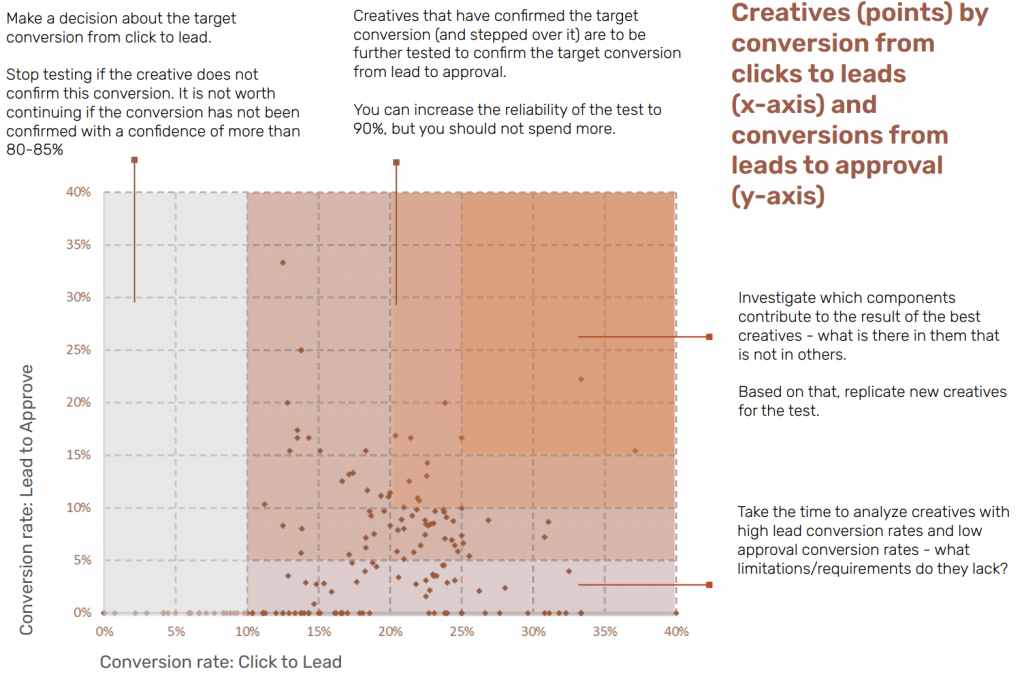
How to calculate the minimum required number of clicks to test your creative hypotheses
Use a probabilistic approach. Your creative has to work for your target conversion. Therefore, select the expected target conversion.
Use the binomial distribution to determine the probability of an event (lead) for each subsequent click. The reliability of your test is the inverse of this probability.
The probability of getting a conversion with each subsequent click
The binomial distribution for the expected conversion is 10%
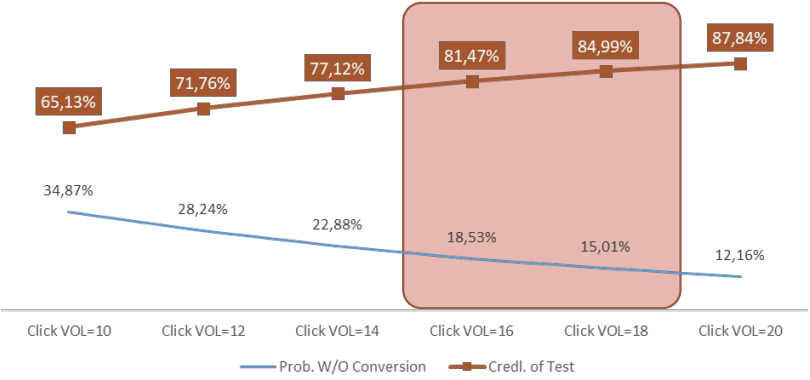
KEY TAKEAWAYS
- Make sure your creative materials are targeting what’s important for the business;
- Use the broad Learning Agenda to test the smallest elements of your message - and let the strongest one win;
- Analyze not only the price per lead or approval, but also the characteristics of the companies. Why are some getting approved for the loan and others are not? How does it depend on what you say in the ad?
- Determine how much you are willing to spend on one test based on your expectations for the result;

04 RESULTS#4. How do we evaluate the results?
4.1 Conversion Rate
The results can vary significantly during each specific week, but the overall trend has to be positive - consistent testing of communication and campaign training on high-quality digital events is to increase conversion week to week.Our task each week was to optimize the conversion rate into loan approval, but in the process we realized that a cheap lead and a cheap approval are non-conflicting tasks.
At the same time, something has been constantly changing, lke landing pages, creatives and texts, processing scripts and target lead parameters
On the chart: Accumulated dynamics of conversion from click to lead and weekly conversion rate
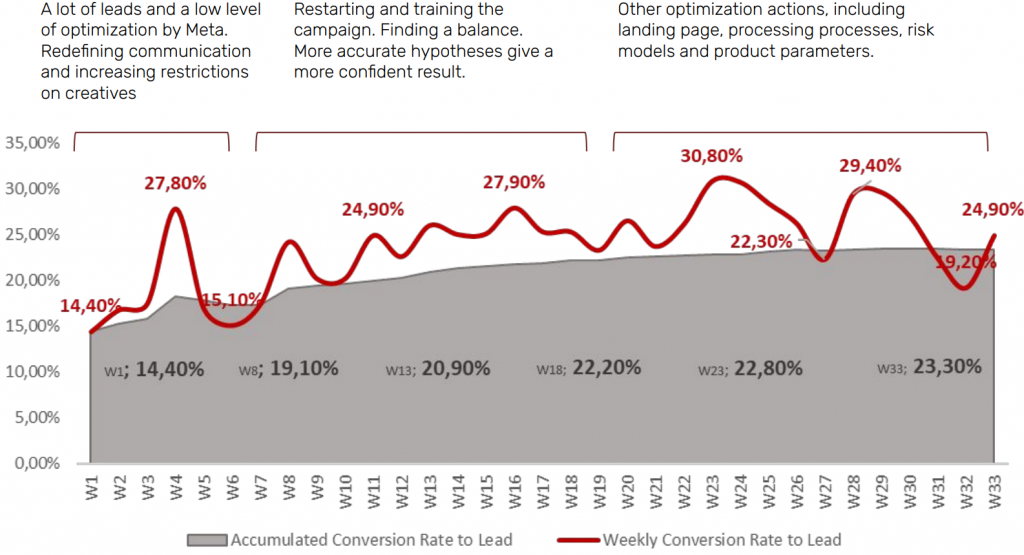
4.1 Approvals
The results can vary significantly during each specific week, but the overall trend has to be positive - consistent testing of communication and campaign training on high-quality digital events is to increase conversion week to week.On the graph: the Cost of Approved loan and the AVG weekly Number of Approvals
in relation to the average results of the first 10 weeks
